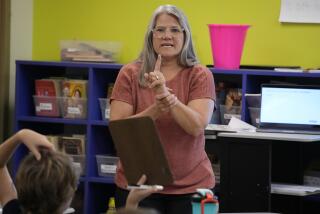Soviet Tells of Effort to Reform Education : Schools: Officials in the U.S.S.R., as in the U.S., are unhappy with the way math and science are being taught. But their solution is almost the opposite of ours, a physicist says in Long Beach.
- Share via
Just as the United States is launching a war on scientific illiteracy, the Soviet Union is also trying to reform science and math education--but in almost exactly the opposite direction.
At a meeting Friday at Cal State Long Beach, a leader of the Soviet reform movement told U.S. educators that the Soviet system fails to educate the best and brightest science and math students.
Unlike the U.S. system, which has focused almost entirely on top students while largely neglecting the vast majority of average and below-average youngsters, the Soviet system is quite adequate for the majority of students. But it provides little special training for extraordinary students, said Michael G. Ivanov, an award-winning Soviet physicist and activist in Soviet education reform.
“These are the students we will need to get us out of our economic problems,” said Ivanov, who was in Los Angeles this week visiting a former student, Alexander Zeyliger, who immigrated to the United States last year and is a freshman at Caltech.
To address his country’s problems, Ivanov and other scientists banded together three years ago to create Phystech High School, the first--and what is now thought to be the finest--independent science high school in the Soviet Union. The school, which offers a vast array of highly sophisticated math and science courses, taught almost entirely by professional researchers, is financed by the Soviet Academy of Sciences.
So successful has the school been in recruiting top-flight students and providing them with in-depth technical and scientific training, scientists in the Soviet Union are now discussing the creation of other similar schools, which in some ways would be like Bronx High School of Science, Stuyvesant High School and other competitive schools for super-achievers in the United States.
The move to reform science and math education in the Soviet Union from the top down came as something of a surprise to U.S. educators who are now involved in their own reform of science and math education.
In the United States, however, reform is moving from the bottom up, in an effort to provide more and better training for average and below-average students who are now thought to be woefully ignorant in science and math.
Ironically, the U.S. reforms have come about because the last education reform movement in this country--the post-Sputnik race to get a man on the moon--largely backfired, leaving the United States with an elitist system very much like the one many Soviet scientists would now like to build in their country.
“I don’t think (Soviet) reforms will accomplish what they want for themselves any more than (the earlier U.S. reforms) did what we wanted,” said Frank Collea, a former physics professor and now a Cal State administrator, who organized Friday’s meeting.
Still, much of the way science and math is taught in the Soviet Union impresses U.S. educators, some of whom are trying to adapt many of the Soviet methods of teaching in U.S. classrooms.
“We begin early with . . . ‘kitchen physics’ experiments, simple experiments that students can understand,” Ivanov said. “Then later students are ready to move into abstract theories, into quantum physics.”
That is very different from the U.S. system, which offers sophisticated courses but without much of the early hands-on experiences that are needed to get students interested in science.
“Maybe someday when we converge both of our approaches, will we both be doing things right,” Ivanov said.
More to Read
Sign up for Essential California
The most important California stories and recommendations in your inbox every morning.
You may occasionally receive promotional content from the Los Angeles Times.













